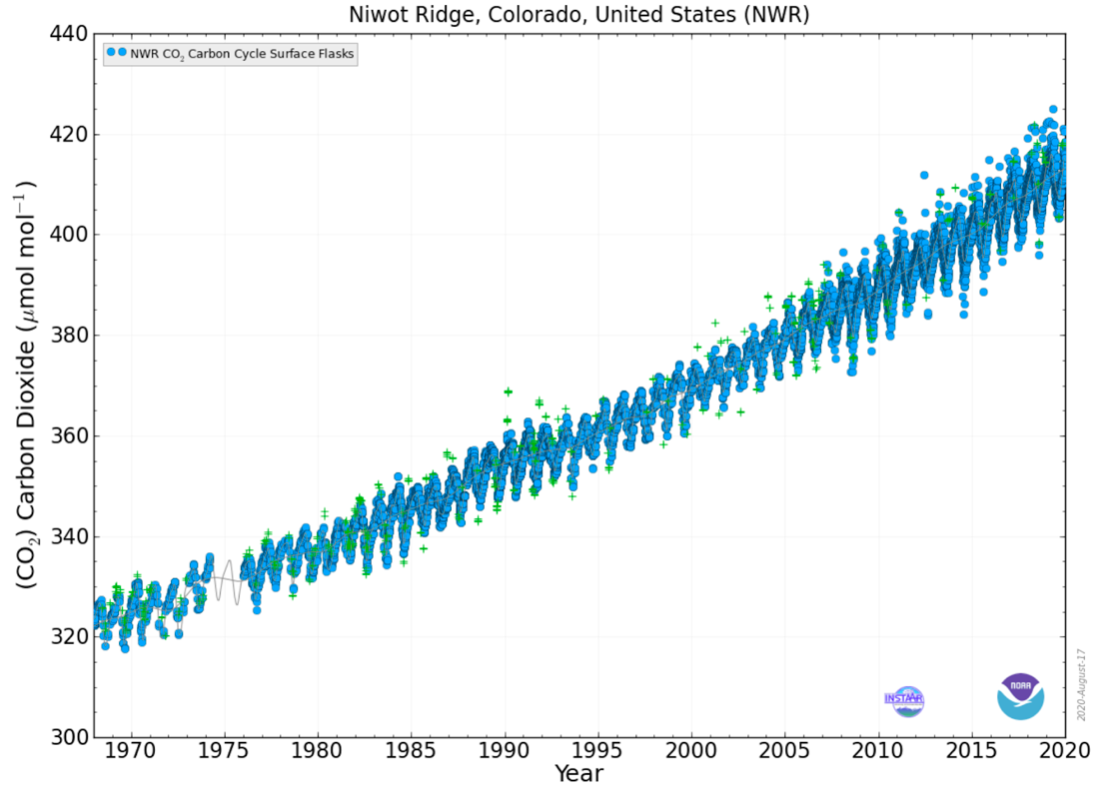Greenhouse gas emissions continue to rise, despite reports of downward trends
Colorado has taken large steps to reduce methane emissions, but NOAA data from Niwot Ridge suggest it’s far too soon to celebrate. Data show that both methane and CO2 in the atmosphere, both warming-causing gases, continue to rise.
Atmospheric greenhouse gases, including methane and CO2, can dramatically impact the course of climate change. In 2014, Colorado became the first in the country to crack down on methane, which can escape from oil and gas wells, lines, equipment and tanks, as well as from landfills, cattle operations and natural seeps. The state started requiring oil companies to regularly inspect and repair leaks at their biggest facilities.
While CO2 persists in the atmosphere for centuries, or even millennia, methane warms the planet on steroids for a decade or two before decaying to CO2. Methane’s potency has made it a target of policymakers looking for a quick way to slow the effects of climate change.
In 2019, Colorado’s lawmakers went further to pass new regulations for the oil and gas industry, including a section to further crack down on methane emissions and the accompanying volatile organic compounds that can escape from wells.
However, data from NOAA’s Global Monitoring Laboratory suggest it may be too soon to celebrate.
Atmospheric samples taken weekly at the Niwot Ridge site show that greenhouse gas emissions continue to increase over time, specifically methane and carbon dioxide. The Niwot Ridge site is a regional background site, so data from this site reflect large scale concentrations in the atmosphere.
explore the data
Comparing methane and carbon dioxide emissions
Figure 1. Methane emissions over time, sampled from air collected weekly at the Niwot Ridge site. Blue circle symbols represent samples from a well-mixed troposphere, while green plus symbols represent poorly-mixed air masses that were influenced by local or regional emissions. Note that any local emissions of greenhouse gases will show up in the data as enhancements to the background concentration. The Niwot Ridge site is a regional background site, which often reflects large scale concentrations in the atmosphere. Source: Data have undergone rigorous quality assurance and are freely available online at the NOAA Global Monitoring Laboratory’s Interactive Data Visualization for the Niwot Ridge site.
Figure 2. Carbon dioxide emissions over time, sampled from air collected weekly at the Niwot Ridge site. Blue circle symbols represent samples from a well-mixed troposphere, while green plus symbols represent poorly-mixed air masses that were influenced by local or regional emissions. Source: Data have undergone rigorous quality assurance and are freely available online at the NOAA Global Monitoring Laboratory’s Interactive Data Visualization for the Niwot Ridge site.
recommendations
Data collection can inform strategies that curb greenhouse gas emissions.
The measurement of atmospheric concentrations of greenhouse gases, particularly CO2 and methane, is complicated by the fact that they come from a variety of sources, and they also mix well with other gases in the atmosphere and are easily transported across land and water. Further enforcement of regulations, by tracking oil and gas wells at the source, and proper investment of funding to monitoring systems and quality controls will build public confidence in our ability to track greenhouse gases that arise from our local industries. That way, we can get a better sense of how effective our current policies are towards reducing greenhouse gases in Boulder and the surrounding counties. Implementing robust monitoring systems and rigorous testing of field and lab equipment will help ensure that data collected on local and state greenhouse gas emissions are reliable and repeatable.
Individuals in Boulder County can also make a dent in greenhouse gas emissions by making personal choices that reduce emissions of greenhouse gases, including choosing to cycle instead of drive, converting to more fuel-efficient vehicles and appliances, and reducing food waste. To learn more about Boulder’s efforts to combat climate change, check out the city of Boulder’s Climate Mobilization Action Plan and Boulder County’s Climate Action initiatives, both of which provide excellent guidance for actions to reduce emissions, such as reducing fossil fuel use in transportation, increasing energy efficiency, and reducing waste that ends up in landfills.




